Fletcher Mountain
June 1, 2008 - Northwest Face (spring snow )
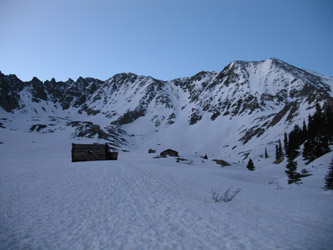
The Rainier/Cascades trip was less than two weeks off and I wanted to knock out another high 13er as part of my conditioning program. The National Weather Service zone forecast was calling for highs possibly reaching the 70's and overnight lows just above freezing. Overall, I took that as a lousy forecast as it clearly would mean a very early alpine start to even have a hope of a snow climb of any stature. Leadville's temp was to drop 31 and I hoped that the snow in Mayflower Gulch would indeed freeze. Well, if it did not, I had a back-up plan to work from . . .
G had to work however Bob, n.k.a. "Snownap," wanted to try his hand at using an ice axe and crampons for the first time. The task of an elementary snow school necessarily became part of the equation, hence an even earlier start. I readily 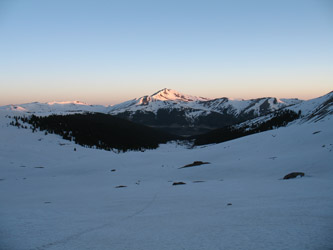 admit that the "alpine start" is part of prudent and safe mountaineering during the spring snow season but that does not mean I have to like it. I also have to make the run to Denver from Cheyenne, adding 100 miles to the trip that would otherwise allow an extra one and a half hours sleep for the average Denver based climber. admit that the "alpine start" is part of prudent and safe mountaineering during the spring snow season but that does not mean I have to like it. I also have to make the run to Denver from Cheyenne, adding 100 miles to the trip that would otherwise allow an extra one and a half hours sleep for the average Denver based climber.
I tried to break the bad news to Bob as easily as anyone can tell someone that we would be leaving my place at 1:00 a.m. I hated to tell him but I hated even more the realization I was responsible for the dread act. Regardless, that was the depart time that I calculated would put me at the trail head at 4:00 a.m. and at the base of the climb by 6:00 and on the summit by 8:00 with a quick turnaround to be out of the couloir by the time the snow went to pot. One o'clock in the morning it would be . . .
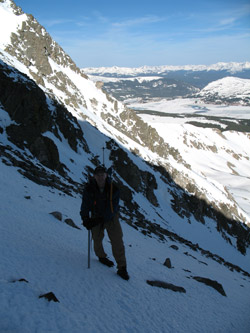 We met on time in front of my place and I bored Bob to death with mindless chatter as we made our way to Mayflower Gulch. But it was that or the onset of the physiological symptoms of having about 2 hours of sleep after tiling a bathroom and completing other honey do's during the course of the preceding day. He survived and I stayed awake. We turned into the trail head parking lot at 4:28, a roughly 3 hour run from Cheyenne to trail head, not bad at all. The temperature was 35 degrees and we emerged from the car into the starry but balmy warm night. I walked up the road a few yards and stuck my foot into the snow . . . frozen styrofoam . . . yes! We met on time in front of my place and I bored Bob to death with mindless chatter as we made our way to Mayflower Gulch. But it was that or the onset of the physiological symptoms of having about 2 hours of sleep after tiling a bathroom and completing other honey do's during the course of the preceding day. He survived and I stayed awake. We turned into the trail head parking lot at 4:28, a roughly 3 hour run from Cheyenne to trail head, not bad at all. The temperature was 35 degrees and we emerged from the car into the starry but balmy warm night. I walked up the road a few yards and stuck my foot into the snow . . . frozen styrofoam . . . yes!
We gathered the plethora of gear from the back of the Toyota and I lamented the extra weight of a 60m ice line that I intended to take along in case we got into a bind in the upper steeps of the couloir . . . and to facilitate a review of rappel, belay and lowering techniques somewhere along the way. I also strapped my snow shoes to the pack, thinking that I'd be happy to have them if the upper valley was full of warm inverted air and we found ourselves making a traverse to the base of the west ridge of Atlantic as our back up climb. At 4:58 we left the car and started up the 1 1/2 mile track to the remains of the Boston Mine and on another 1/2 mile to the base of the climb.
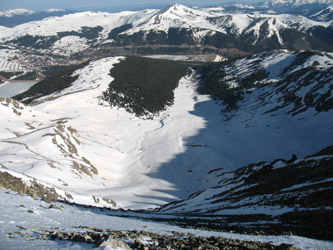 Bob and I conversed about snow climbing techniques for the length of the walk and before I knew it we were trudging past the snow beaten cabins that remain of the mine after a century of winters. The snow on the road was still drifted from two to six feet deep but it was warm and you could tell by the bare spots here and there that summer was indeed coming on fast. We stopped at a bare patch of rock just before the slope took an upward tilt and headed up the couloir for the saddle between Drift and Fletcher. I got Bob set up with the crampons on his boots, mine as well, and then we spent perhaps 20 minutes reviewing ice axe arrest techniques, positions, do's and don'ts, with most of the time spent down on the snow working through the particularities of the arrest. Bob and I conversed about snow climbing techniques for the length of the walk and before I knew it we were trudging past the snow beaten cabins that remain of the mine after a century of winters. The snow on the road was still drifted from two to six feet deep but it was warm and you could tell by the bare spots here and there that summer was indeed coming on fast. We stopped at a bare patch of rock just before the slope took an upward tilt and headed up the couloir for the saddle between Drift and Fletcher. I got Bob set up with the crampons on his boots, mine as well, and then we spent perhaps 20 minutes reviewing ice axe arrest techniques, positions, do's and don'ts, with most of the time spent down on the snow working through the particularities of the arrest.
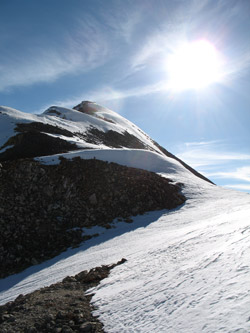 The couloir is described in the Roach guidebook as averaging 31 degrees with a stretch going to 40+ degrees of so. Looking at the route, I had no doubt that it would be lucky to get much past 30 degrees and I just did not see a steeper section . . . (I now know that I need to have my eyes checked.) We started up the first section and worked on axe positions, switchovers at the turns, turning technique, French footing, front pointing, and the ice axe belay. All was going fine and we climbed on up the couloir. At a bit past the mid point, the slope stiffened and I found out that Mr. Roach was dead on in his description, that my slope perception was poor in the low light and that Bob was doing just fine and was comfortable with the climb so far. The couloir is described in the Roach guidebook as averaging 31 degrees with a stretch going to 40+ degrees of so. Looking at the route, I had no doubt that it would be lucky to get much past 30 degrees and I just did not see a steeper section . . . (I now know that I need to have my eyes checked.) We started up the first section and worked on axe positions, switchovers at the turns, turning technique, French footing, front pointing, and the ice axe belay. All was going fine and we climbed on up the couloir. At a bit past the mid point, the slope stiffened and I found out that Mr. Roach was dead on in his description, that my slope perception was poor in the low light and that Bob was doing just fine and was comfortable with the climb so far.
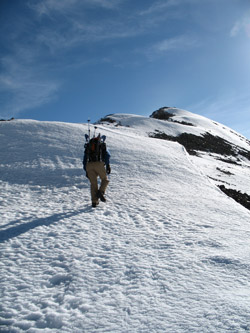 We continued on through the steep section, which while you are climbing appears to slacken at the top, but does not really do so until you are within a stone's throw of the saddle. We topped out onto the saddle and looked to our left at the sinuous ridge leading to the summit of Fletcher. The ridge had a wonderfully solid snow load that would make for a ridge climb quite unlike many of the more mellow summits I've often experienced in Colorado snow climbs. I told Bob to take the last 200 feet of vertical and I followed along, taking pictures along the way. We wasted little time in summitting and once atop I snapped a few more photos before we broke out the ceremonial gummi worms, de rigueur for the summit. I had a few, Bob had a few, and I, of course, placed on a rock for Pachamama . . . one of those Andean habits that never seems to hurt. We continued on through the steep section, which while you are climbing appears to slacken at the top, but does not really do so until you are within a stone's throw of the saddle. We topped out onto the saddle and looked to our left at the sinuous ridge leading to the summit of Fletcher. The ridge had a wonderfully solid snow load that would make for a ridge climb quite unlike many of the more mellow summits I've often experienced in Colorado snow climbs. I told Bob to take the last 200 feet of vertical and I followed along, taking pictures along the way. We wasted little time in summitting and once atop I snapped a few more photos before we broke out the ceremonial gummi worms, de rigueur for the summit. I had a few, Bob had a few, and I, of course, placed on a rock for Pachamama . . . one of those Andean habits that never seems to hurt.
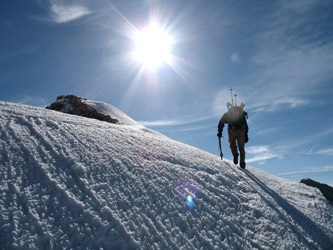 We tracked our way back to the saddle and then heel stepped our way about 50% of the way down the couloir to a prominent fin on the right side. I'd spotted this steep sidewall on the way up and we stopped to break out the rope, picket, and technical gear. Bob had never rappelled or done any other rope work so this semi shaded and wind free spot seemed like a good place to spend an hour or two working through rope evolutions. We covered the main points and then noted it was time to get on down before the sun really rotted the snow and we were faced with a postholing retreat to the parking area. We packed the rope, the harnesses, and off we went down slope, landing at the bare rock spot to drop a layer, put away the axes and crampons and start our hike to the car about 1 3/4 miles distant. We tracked our way back to the saddle and then heel stepped our way about 50% of the way down the couloir to a prominent fin on the right side. I'd spotted this steep sidewall on the way up and we stopped to break out the rope, picket, and technical gear. Bob had never rappelled or done any other rope work so this semi shaded and wind free spot seemed like a good place to spend an hour or two working through rope evolutions. We covered the main points and then noted it was time to get on down before the sun really rotted the snow and we were faced with a postholing retreat to the parking area. We packed the rope, the harnesses, and off we went down slope, landing at the bare rock spot to drop a layer, put away the axes and crampons and start our hike to the car about 1 3/4 miles distant.
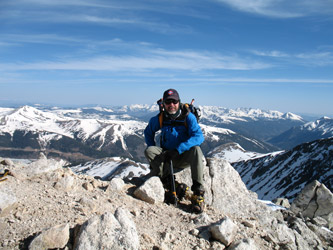 We passed the mine ruins with but a few post holing stumbles and then trudged down the mile and half of road, whose drifts steadily went to crap with every descending foot and every ascending degree of air temperature. It was a trudge but at a bit after 12 noon, we arrived at the car, a summit in hand, a couple hours of training and practice behind us, and a new convert to climbing in the pre-Cottoneering season. We passed the mine ruins with but a few post holing stumbles and then trudged down the mile and half of road, whose drifts steadily went to crap with every descending foot and every ascending degree of air temperature. It was a trudge but at a bit after 12 noon, we arrived at the car, a summit in hand, a couple hours of training and practice behind us, and a new convert to climbing in the pre-Cottoneering season.
Drift Peak, Fletcher's next door neighbor . . .
|


 admit that the "alpine start" is part of prudent and safe mountaineering during the spring snow season but that does not mean I have to like it. I also have to make the run to Denver from Cheyenne, adding 100 miles to the trip that would otherwise allow an extra one and a half hours sleep for the average Denver based climber.
admit that the "alpine start" is part of prudent and safe mountaineering during the spring snow season but that does not mean I have to like it. I also have to make the run to Denver from Cheyenne, adding 100 miles to the trip that would otherwise allow an extra one and a half hours sleep for the average Denver based climber.  We met on time in front of my place and I bored Bob to death with mindless chatter as we made our way to Mayflower Gulch. But it was that or the onset of the physiological symptoms of having about 2 hours of sleep after tiling a bathroom and completing other honey do's during the course of the preceding day. He survived and I stayed awake. We turned into the trail head parking lot at 4:28, a roughly 3 hour run from Cheyenne to trail head, not bad at all. The temperature was 35 degrees and we emerged from the car into the starry but balmy warm night. I walked up the road a few yards and stuck my foot into the snow . . . frozen styrofoam . . . yes!
We met on time in front of my place and I bored Bob to death with mindless chatter as we made our way to Mayflower Gulch. But it was that or the onset of the physiological symptoms of having about 2 hours of sleep after tiling a bathroom and completing other honey do's during the course of the preceding day. He survived and I stayed awake. We turned into the trail head parking lot at 4:28, a roughly 3 hour run from Cheyenne to trail head, not bad at all. The temperature was 35 degrees and we emerged from the car into the starry but balmy warm night. I walked up the road a few yards and stuck my foot into the snow . . . frozen styrofoam . . . yes!  Bob and I conversed about snow climbing techniques for the length of the walk and before I knew it we were trudging past the snow beaten cabins that remain of the mine after a century of winters. The snow on the road was still drifted from two to six feet deep but it was warm and you could tell by the bare spots here and there that summer was indeed coming on fast. We stopped at a bare patch of rock just before the slope took an upward tilt and headed up the couloir for the saddle between Drift and Fletcher. I got Bob set up with the crampons on his boots, mine as well, and then we spent perhaps 20 minutes reviewing ice axe arrest techniques, positions, do's and don'ts, with most of the time spent down on the snow working through the particularities of the arrest.
Bob and I conversed about snow climbing techniques for the length of the walk and before I knew it we were trudging past the snow beaten cabins that remain of the mine after a century of winters. The snow on the road was still drifted from two to six feet deep but it was warm and you could tell by the bare spots here and there that summer was indeed coming on fast. We stopped at a bare patch of rock just before the slope took an upward tilt and headed up the couloir for the saddle between Drift and Fletcher. I got Bob set up with the crampons on his boots, mine as well, and then we spent perhaps 20 minutes reviewing ice axe arrest techniques, positions, do's and don'ts, with most of the time spent down on the snow working through the particularities of the arrest. The couloir is described in the Roach guidebook as averaging 31 degrees with a stretch going to 40+ degrees of so. Looking at the route, I had no doubt that it would be lucky to get much past 30 degrees and I just did not see a steeper section . . . (I now know that I need to have my eyes checked.) We started up the first section and worked on axe positions, switchovers at the turns, turning technique, French footing, front pointing, and the ice axe belay. All was going fine and we climbed on up the couloir. At a bit past the mid point, the slope stiffened and I found out that Mr. Roach was dead on in his description, that my slope perception was poor in the low light and that Bob was doing just fine and was comfortable with the climb so far.
The couloir is described in the Roach guidebook as averaging 31 degrees with a stretch going to 40+ degrees of so. Looking at the route, I had no doubt that it would be lucky to get much past 30 degrees and I just did not see a steeper section . . . (I now know that I need to have my eyes checked.) We started up the first section and worked on axe positions, switchovers at the turns, turning technique, French footing, front pointing, and the ice axe belay. All was going fine and we climbed on up the couloir. At a bit past the mid point, the slope stiffened and I found out that Mr. Roach was dead on in his description, that my slope perception was poor in the low light and that Bob was doing just fine and was comfortable with the climb so far. We continued on through the steep section, which while you are climbing appears to slacken at the top, but does not really do so until you are within a stone's throw of the saddle. We topped out onto the saddle and looked to our left at the sinuous ridge leading to the summit of Fletcher. The ridge had a wonderfully solid snow load that would make for a ridge climb quite unlike many of the more mellow summits I've often experienced in Colorado snow climbs. I told Bob to take the last 200 feet of vertical and I followed along, taking pictures along the way. We wasted little time in summitting and once atop I snapped a few more photos before we broke out the ceremonial gummi worms, de rigueur for the summit. I had a few, Bob had a few, and I, of course, placed on a rock for Pachamama . . . one of those Andean habits that never seems to hurt.
We continued on through the steep section, which while you are climbing appears to slacken at the top, but does not really do so until you are within a stone's throw of the saddle. We topped out onto the saddle and looked to our left at the sinuous ridge leading to the summit of Fletcher. The ridge had a wonderfully solid snow load that would make for a ridge climb quite unlike many of the more mellow summits I've often experienced in Colorado snow climbs. I told Bob to take the last 200 feet of vertical and I followed along, taking pictures along the way. We wasted little time in summitting and once atop I snapped a few more photos before we broke out the ceremonial gummi worms, de rigueur for the summit. I had a few, Bob had a few, and I, of course, placed on a rock for Pachamama . . . one of those Andean habits that never seems to hurt. We tracked our way back to the saddle and then heel stepped our way about 50% of the way down the couloir to a prominent fin on the right side. I'd spotted this steep sidewall on the way up and we stopped to break out the rope, picket, and technical gear. Bob had never rappelled or done any other rope work so this semi shaded and wind free spot seemed like a good place to spend an hour or two working through rope evolutions. We covered the main points and then noted it was time to get on down before the sun really rotted the snow and we were faced with a postholing retreat to the parking area. We packed the rope, the harnesses, and off we went down slope, landing at the bare rock spot to drop a layer, put away the axes and crampons and start our hike to the car about 1 3/4 miles distant.
We tracked our way back to the saddle and then heel stepped our way about 50% of the way down the couloir to a prominent fin on the right side. I'd spotted this steep sidewall on the way up and we stopped to break out the rope, picket, and technical gear. Bob had never rappelled or done any other rope work so this semi shaded and wind free spot seemed like a good place to spend an hour or two working through rope evolutions. We covered the main points and then noted it was time to get on down before the sun really rotted the snow and we were faced with a postholing retreat to the parking area. We packed the rope, the harnesses, and off we went down slope, landing at the bare rock spot to drop a layer, put away the axes and crampons and start our hike to the car about 1 3/4 miles distant. We passed the mine ruins with but a few post holing stumbles and then trudged down the mile and half of road, whose drifts steadily went to crap with every descending foot and every ascending degree of air temperature. It was a trudge but at a bit after 12 noon, we arrived at the car, a summit in hand, a couple hours of training and practice behind us, and a new convert to climbing in the pre-Cottoneering season.
We passed the mine ruins with but a few post holing stumbles and then trudged down the mile and half of road, whose drifts steadily went to crap with every descending foot and every ascending degree of air temperature. It was a trudge but at a bit after 12 noon, we arrived at the car, a summit in hand, a couple hours of training and practice behind us, and a new convert to climbing in the pre-Cottoneering season.